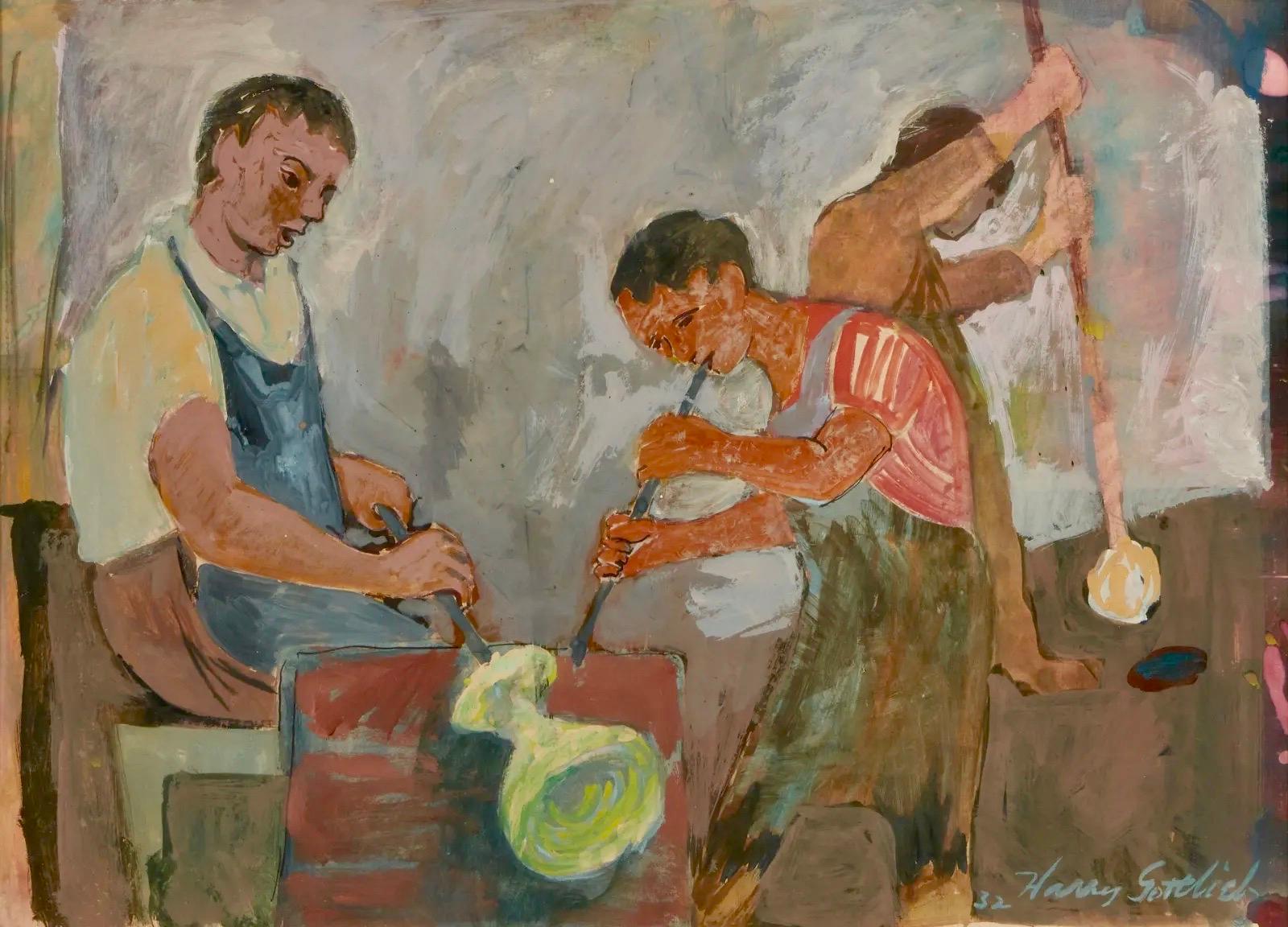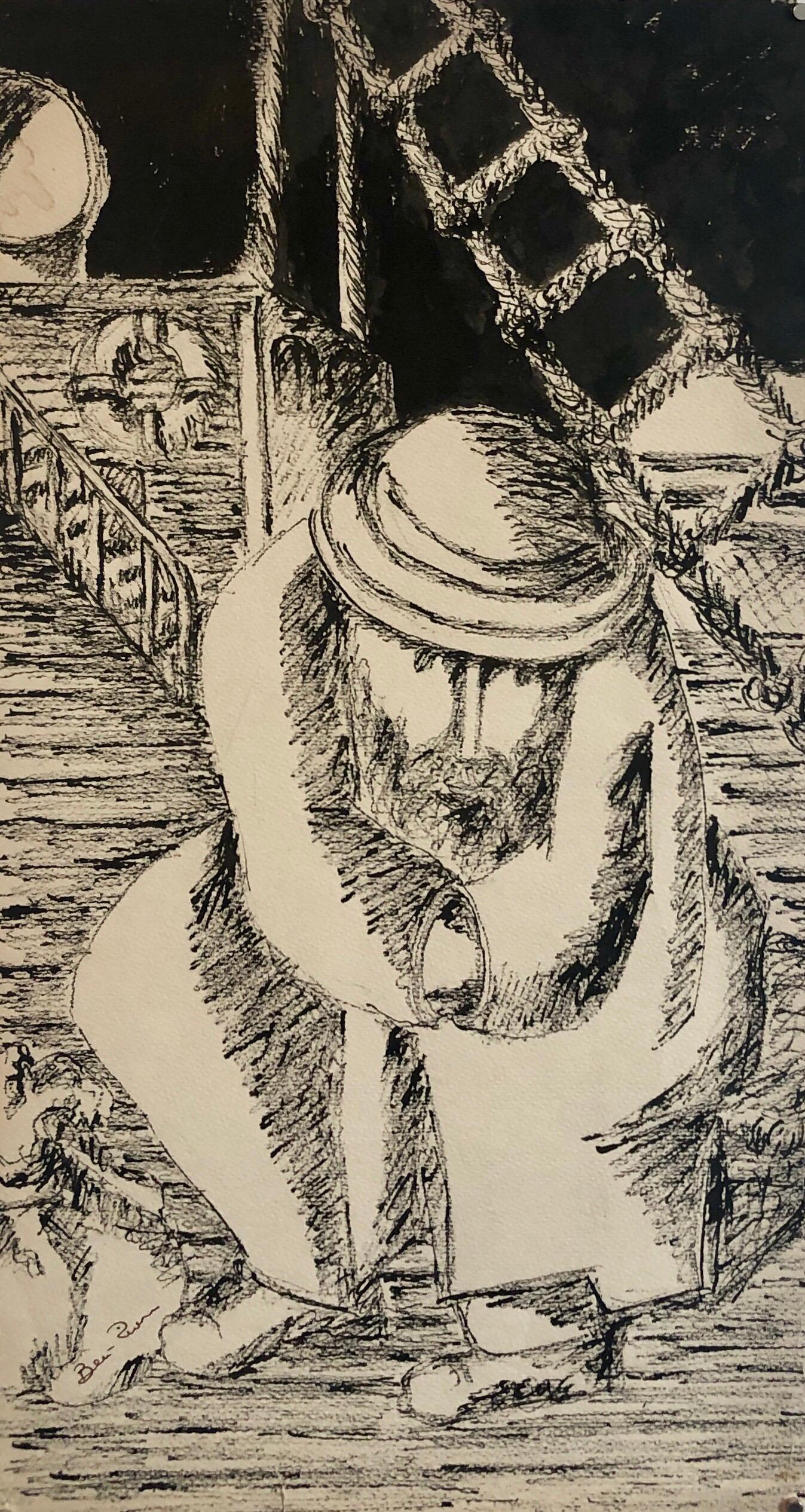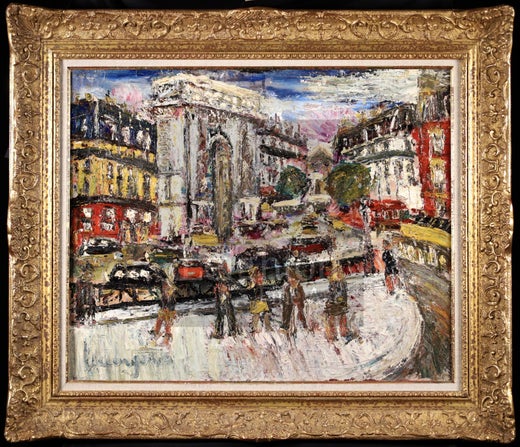Items Similar to Paris la Bourse
Want more images or videos?
Request additional images or videos from the seller
1 of 24
Lucien GéninParis la Boursecirca 1930s
circa 1930s
About the Item
'Paris, la Bourse', gouache on paper, by Lucien Génin (circa 1930s). Created at the beginning of the 19th century by Napoleon, la Bourse, or the Stock Exchange, was intended to assert and encourage France’s prosperity in industry and trade. In 1826 the Stock Exchange was installed in the palace that the architect Brongniart had begun in 1808. Surrounded by a large peristyle of Corinthian columns, the rectangular structure reflects the official neo-classicism of the Empire Period. The artist, Génin, depicts a typically lively 1930s day in front of the building with cars of the period zooming by pedestrians on the walkway and others on the stairs leading to the entrance. He has an extremely charming, almost childlike style particularly the way he renders the people and the vehicles. The building, on the other hand, is accurate in its detail and more seriously presented. Our gallery has held and has sold over a dozen of Genin's paintings but this one stands out for its pure stylish appeal and ability to captivate while inducing a smile in the viewer. The artwork is in good overall condition - there are some minor blemishes not on the artwork itself but on the edges of the mount to which it is attached. The frame is in fair condition showing some nicks and scratches. Please enjoy the many photos accompanying the listing. Upon request a video can be provided. Signed by the artist in the lower right hand.
About the Artist: After the devastation of the First World War, Lucien Génin (1894 - 1953) left his provincial home in the autumn of 1919 to find his fortune among the lively Parisians in the heart of Montmartre. Génin befriended the painters Frank Will, Gen Paul, Émile Boyer, Marcel Leprin, as well as Max Jacob and Dorival. Not concerning himself with producing "art", he beautifully captured the spirit of Paris between the wars while enjoying a truly Bohemian existence. Génin's works, in all their forms, perfectly convey the eclectic and friendly characters of the city. More than a painter of Paris, Génin is a painter of Parisians, of the passion that animates all his characters in the big city. He painted them in the alleys of Montmartre, dining on Place du Tertre, singing in the Lapain Agile, or in a car passing by on the grands boulevards. He exhibited his works at the Salon d'Automne in 1930. Those paintings were witness to the end of the Roaring Twenties and the beginning of the world depression of 1929. The art critics stated that he created intelligent, composed, colourful, sensitive, skilful, delicate, humorous and witty works of art. A painting by Lucien Génin was awarded an important prize from the Art Institute of Chicago in 1932. When they do become available, Génin's artworks inspire spirited bidding at international auction houses as values increase along with his stature in the art world. This gallery holds several works by Génin on this platform. Please feel free to make enquiries.
Dimensions with frame:
H 41.5 cm / 16.3"
W 52.5 cm / 20.7"
Dimensions without frame:
H 23 cm / 9.1"
W 31 cm / 12.2"
- Creator:Lucien Génin (1894 - 1953, French)
- Creation Year:circa 1930s
- Dimensions:Height: 16.34 in (41.5 cm)Width: 20.67 in (52.5 cm)
- Medium:
- Period:
- Condition:
- Gallery Location:London, GB
- Reference Number:
Lucien Génin
Lucien Génin was known for his lush depictions of Paris. After the devastation of the First World War, Génin left his provincial home in the autumn of 1919 to find his fortune among the lively Parisians in the heart of Montmartre. Not concerning himself with producing art, he beautifully captured the spirit of Paris between the wars while enjoying a truly Bohemian existence. Génin's works, in all their forms, perfectly convey the eclectic and friendly characters of the city.
About the Seller
5.0
Platinum Seller
These expertly vetted sellers are 1stDibs' most experienced sellers and are rated highest by our customers.
Established in 2016
1stDibs seller since 2017
439 sales on 1stDibs
Typical response time: <1 hour
- ShippingRetrieving quote...Ships From: London, United Kingdom
- Return PolicyA return for this item may be initiated within 7 days of delivery.
More From This SellerView All
- Church of Saint-Nicolas du Chardonnet in ParisBy Lucien GéninLocated in London, GB'The Church of Saint-Nicolas du Chardonnet, Paris', gouache on art paper by Lucien Génin (circa 1930s). In Paris' 5th Arrondissement the site in which Saint-Nicolas du Chardonnet is ...Category
1930s Expressionist Figurative Paintings
MaterialsPaper, Gouache
- Emile's TavernBy Lucien GéninLocated in London, GB'Emile's Tavern', gouache on paper (circa 1930s), by Lucien Génin. A tavern in French is called a 'guinguette'. With the rise in living standards from the 1860s along with the develo...Category
1930s Expressionist Figurative Paintings
MaterialsPaper, Gouache
- Sacré-Coeur Montmartre at Willette Square ParisBy Lucien GéninLocated in London, GB'Sacré-Coeur, Montmartre at Willette Square, Paris', gouache on art paper (circa 1930s), by Lucien Génin. Created by the Director of Public Ways and Promenades under Napoleon III, Sq...Category
1930s Expressionist Figurative Paintings
MaterialsPaper, Gouache
- Chinatown, San FranciscoBy Edward Wilson CurrierLocated in London, GB'Chinatown, San Francisco', gouache on fine art paper, by Edward Wilson Currier (1903). Spofford Alley in San Francisco's Chinatown is best known for an address (number 36) where Dr. Sun Yat-Sen plotted the overthrow of China's last dynasty. During Prohibition, it was the site of turf battles over local bootlegging and protection rackets. Today it is lined with seniors' community centres. However, the quiet alley livens up in the evenings when a Chinese orchestra strikes up a tune, mah-jongg games begin with a cascade of clicking tiles, and barbers and florists use the pretence of sweeping their doorsteps to gossip. In this artist's depiction, a man smokes a long-stemmed Chinese pipe under the awning and colourful lanterns hanging from the wooden supports while a child looks on. The artwork is interesting from several standpoints including architectural, cultural and historical. Shortly after this work was painted, the neighbourhood was completely destroyed in the 1906 earthquake that levelled most of the city. From 1910 to 1940, Chinese immigrants were detained at the Angel Island...Category
Early 1900s Expressionist Figurative Drawings and Watercolors
MaterialsGouache, Paper
- 'Cabaret in an Asian Banquet Hall', French SchoolLocated in London, GB'Cabaret in an Asian Banquet Hall', pencil, gouache and metallic paint on card stock by an unnamed artist of the French School (20th Century). This is a fantastical port visit of the artist's imagination. It is a naive, but strangely compelling painting discovered in Paris. It depicts French sailors dancing with a cabaret performer in a Chinese-style banquet hall while onlookers enjoy the spectacle. On the left hand of the scene an Asian musician...Category
20th Century Figurative Drawings and Watercolors
MaterialsGouache, Pencil
- 'International Bar', French SchoolLocated in London, GB'International Bar, pencil, ink and gouache on card stock by an unnamed artist of the French School (20th Century). This appears to be a fantastical port visit of the artist's imagination. It is very lively in colour and in subject. The artwork was discovered in Paris along with several others of the same character, most likely by the same person. It depicts the entryway of a brightly lit Asian bar...Category
20th Century Figurative Drawings and Watercolors
MaterialsInk, Gouache, Pencil
You May Also Like
- Sea Battle - (Stories from the Edda)By Arthur RackhamLocated in Miami, FLSigned, "A Rackham" lower right Sotheby's New York - The work has recently been elegantly framed with a high end frame and archivalled matted and looks wonderful in person. Arth...Category
Early 1900s Impressionist Figurative Drawings and Watercolors
MaterialsWatercolor, India Ink, Gouache
- Haitian Scene #7 Mid Century modern painting by renowned artist, signed AA labelBy Adolf DehnLocated in New York, NYAdolf Arthur Dehn Haitian Scene #7, ca. 1951 Watercolor gouache, hand signed; framed with AAA Gallery label verso Signed on the front bearing the origina...Category
Mid-20th Century Modern Figurative Drawings and Watercolors
MaterialsWatercolor, Gouache, Mixed Media
- Glassblowers WPA American Scene Mid- 20th Century Modern Figurative Workers 1932By Harry GottliebLocated in New York, NYGlassblowers WPA American Scene Mid- 20th Century Modern Figurative Workers. Dated and signed "32 Harry Gottlieb" lower right. Sight: 13 1/8" H x 18 1/4" W. Harry Gottlieb, painter, screenprinter, educator, and lithographer, was born in Bucharest, Rumania. He emigrated to America in 1907, and his family settled in Minneapolis. From 1915 to 1917, Gottlieb attended the Minneapolis Institute of Arts. After a short stint as an illustrator for the U.S. Navy, Gottlieb moved to New York City; he became a scenic and costume designer for Eugene O"Neill's Provincetown Theater Group. He also studied at the Philadelphia Academy of Fine Arts and the National Academy of Design. He was one of America's first Social Realist painters, influenced by that Robert Henri-led movement in New York City where Gottlieb settled in 1918. He was also a pioneer in screen printing, which he learned while working for the WPA. He married Eugenie Gershoy, and the couple joined the artist colony at Woodstock, New York. He lectured widely on art education. In 1923, Gottlieb settled in Woodstock, New York and in 1931, spent a a year abroad studying under a Guggenheim Fellowship. In 1935, he joined the Federal Art Project...Category
1930s American Modern Figurative Paintings
MaterialsPaper, Gouache
- The Turkish Yataghan, Illustration of Baby, Collier's CoverBy Charles TwelvetreesLocated in Miami, FLBaby caring a horse shoe on his shoulders reminiscent of the famous J. C. Leyendecker Baby covers for the Saturday Evening Post. This is a cover illustration/ painting for Collie...Category
1930s American Realist Figurative Paintings
MaterialsWatercolor, Gouache
- Modernist Judaica Jewish Ink Drawing Painting "New Immigrant" Off the Boat WPABy Ben-Zion WeinmanLocated in Surfside, FLAn ink drawing Judaic painting by modern artist Ben-Zion Weinman. It depicts a portrait of an old Jewish man. Coming over from Europe on a ship crossing. The work is signed "Ben-Zion". Born in 1897, Ben-Zion Weinman celebrated his European Jewish heritage in his visual works as a sculptor, painter, and printmaker. Influenced by Spinoza, Knut Hamsun, and Wladyslaw Reymont, as well as Hebrew literature, Ben-Zion wrote poetry and essays that, like his visual work, attempt to reveal the deep “connection between man and the divine, and between man and earth.” An emigrant from the Ukraine, he came to the US in 1920. He wrote fairy tales and poems in Hebrew under the name Benzion Weinman, but when he began painting he dropped his last name and hyphenated his first, saying an artist needed only one name. In 1920 he settled in America, where he found little interest in his writing. He began teaching Hebrew to support himself and then in the early 1930s returned to painting. He used his art to comment on the rise of fascism in Europe, events he felt could not be adequately explored with words. Largely self-taught, Ben-Zion visited the museums of New York City to learn his new trade. His first painting on a large scale, Friday Evening (1933, Jewish Museum, New York), depicts a Sabbath dinner table as recalled from his family home. Ben-Zion supported himself by working odd jobs until the establishment of the Works Progress Administration's Federal Art Project. Under the auspices of the wpa, Ben-Zion thrived and galleries began to show his work. In 1936, after his first one-man show at the Artists' Gallery in New York Ben-Zion was a founding member of “The Ten: An Independent Group” The Ten” a 1930’s...Category
1940s American Modern Figurative Paintings
MaterialsWatercolor, Gouache
- Chicago Jewish Modernist Judaica Painting Simchat Torah WPA Artist Israeli FlagsBy Alexander Raymond KatzLocated in Surfside, FLThis has young ISraeli pioneers dancing with the flag as typical of works of the late British mandate Palestine era early state of Israel. Genre: Modern Subject: Figurative (stained glass style) Medium: Mixed media gouache on paper Hand signed lower left Alexander Raymond Katz, Hungarian / American (1895 – 1974) Alexander Raymond Katz was born in Kassa, Hungary, and came to the United States in 1909. He studied at the Art Institute of Chicago and the Chicago Academy of Fine Arts. In the late 1920s, he worked as a director of the Poster Department at Paramount Studios. He was appointed the Director of Posters for the Chicago Civic Opera in 1930. During the Great Depression, notable architect Frank Lloyd Wright urged Katz to become a muralist. In 1933, he was commissioned to paint a mural for the Century of Progress exposition in Chicago. In 1936, he painted the mural History of the Immigrant for the Madison, Ill., post office. Katz’s works were included in various exhibitions and now are part of several museum collections, including those of the Art Institute of Chicago; Corcoran Gallery of Art, Washington, D.C.; and the Jewish Museum, New York. His murals, bas-reliefs and stained glass designs adorn more than 200 Jewish synagogues in the United States. Katz and other Jewish artists in Chicago who expressed Jewish and Biblical themes were inspired by the artist Abel Pann (1883-1963). Pann, who is regarded as the leading painter of the Land of Israel, exhibited in the Art Institute of Chicago in 1920. Early in his career, Katz began to explore the artistic possibilities inherent in the characters of the Hebrew alphabet. He developed aesthetic and philosophical interpretations of each letter and became the leading innovator and pioneer in the field of Hebraic art. Katz applies this concept in the woodcut Moses and the Burning Bush. Hebrew letters appears in Moses’ head, his cane and inside the flame. The initial of Moses’ name crowns his head. The letter in the flame is the first letter of the name of God. A combination of images and Hebrew letters appeared commonly in illustrations of the scene Moses and the Burning Bush in the Haggadah, the book of Passover. The symbolism of the burning bush corresponds to the motifs of A Gift to Biro-Bidjan. Among the fourteen participating artists were notable Chicago modernists Todros Geller, Mitchell Siporin...Category
Mid-20th Century Modern Figurative Paintings
MaterialsPaper, Gouache
Recently Viewed
View AllMore Ways To Browse
Paris Photo
Photos Of Paris
Vintage Photos Paris
Stock Exchange
Paris Painting Montmartre
Boyer Paris
Montmartre Frame
Framed Car Photo
Provincial Art Frames
Large Rectangular Paintings
La Fortune
Empire State Building Vintage
Empire State Building Painting
Vintage Big Boy
French Provincial Artwork
Marcel Cars
Lucien Frank
Empire State Building Vintage Photos






